
Bank of America Plaza is a supertall skyscraper between Midtown Atlanta and Downtown Atlanta. At 311.8 m (1,023 ft), as of February 2024 the tower is the 23rd tallest building in the United States, the tallest building in the Southeastern region of the United States, and the tallest building in any U.S. state capital, overtaking the 250 m (820 ft), 50-story One Atlantic Center in height, which held the record as Georgia's tallest building. It has 55 stories of office space and was completed in 1992, when it was called NationsBank Plaza. Originally intended to be the headquarters for Citizens & Southern National Bank, it became NationsBank's property following its formation in the 1991 hostile takeover of C&S/Sovran by NCNB.
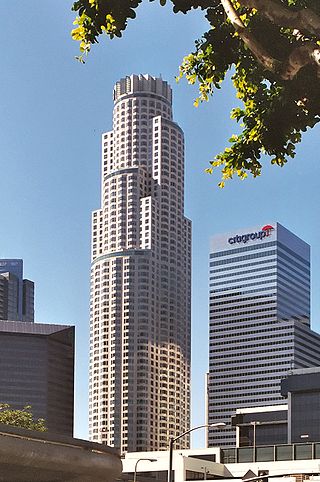
U.S. Bank Tower, known locally as the Library Tower and formerly as the First Interstate Bank World Center, is a 1,018-foot (310.3 m) skyscraper in downtown Los Angeles, California. It is, by structural height, the third-tallest building in California, the second-tallest building in Los Angeles, the 24th-tallest in the United States, the third-tallest west of the Mississippi River after the Salesforce Tower and the Wilshire Grand Center, and the 129th-tallest building in the world, after being surpassed by the Wilshire Grand Center. However, the U.S. Bank Tower does surpass both the Salesforce Tower and the Wilshire Grand Center in roof height, making it the only building in California whose roof height exceeds 1,000 feet (300 m). Because local building codes required all high-rise buildings to have a helipad, it was known as the tallest building in the world with a rooftop heliport from its completion in 1989 to 2010 when the China World Trade Center Tower III opened. It is also the third-tallest building in a major active seismic region; its structure was designed to resist an earthquake of 8.3 on the Richter scale. It consists of 73 stories above ground and two parking levels below ground. Construction began in 1987 with completion in 1989. The building was designed by Henry N. Cobb of the architectural firm Pei Cobb Freed & Partners and cost $350 million to build. It is one of the most recognizable buildings in Los Angeles, and often appears in establishing shots for the city in films and television programs.

Salesforce Tower is the tallest building in the U.S. state of Indiana. Opening in 1990, it surpassed the AUL Tower in Indianapolis for the distinction. The building's twin spires' are 811 feet (247 m) tall, while the 48 floors of office and retail space and 2 building equipment floors above that peak at the 701-foot (214 m) roof. It is the regional headquarters of Salesforce, which moved into the tower in the late-2010s and currently occupies a large amount of space in the building. While the tower has two spires of equal height, only one of them is functional as a transmission antenna. The other mast is merely an architectural decoration. The building was designed by KlingStubbins, and built by Indianapolis-based Huber Hunt & Nichols.
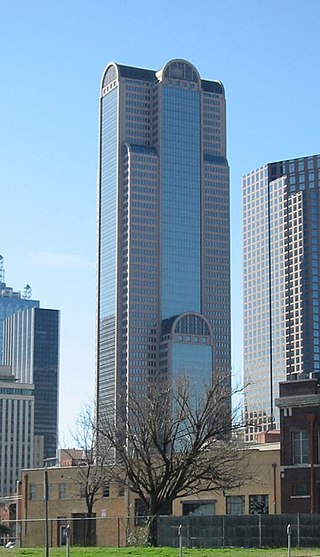
Comerica Bank Tower is a 60-story postmodern skyscraper located at 1717 Main Street in the Main Street District in downtown Dallas, Texas. Standing at a structural height of 787 feet (240 m), it is the third tallest skyscraper in the city of Dallas. It is also the sixth tallest building in Texas and the 61st tallest building in the United States. The building was designed by Philip Johnson and John Burgee, and was completed in 1987. The structure has 1,500,000 square feet (100,000 m2) of office space.

The Citigroup Centre is a building complex in London. It houses Citigroup's EMEA headquarters and is located in Canary Wharf in the city's Docklands. The centre provides 170,000 square metres (1,800,000 sq ft) of floor space across two buildings - 33 Canada Square and 25 Canada Square, and houses the bulk of Citi's UK employee base. The buildings were separated in 2023, prior to a £100m renovation of 25 Canada square.

The Sun Life Building is a historic 122-metre (400 ft), 24-storey office building at 1155 Metcalfe Street on Dorchester Square in the city's downtown core of Montreal, Quebec, Canada.

Buffalo City Hall is the seat for municipal government in the City of Buffalo, New York. Located at 65 Niagara Square, the 32-story Art Deco building was completed in 1931 by Dietel, Wade & Jones.
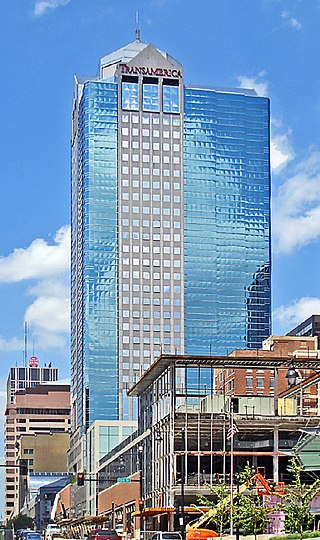
1111 Main is a 38-story, 180.1 m (591 ft) skyscraper at 1111 Main Street on the northeast corner of 12th and Main Streets in Downtown Kansas City, Missouri, around the corner from Oppenstein Brothers Memorial Park. The tower occupies the former site of several retail buildings, including Kline's Department Store and Kresge's Dime Store. The 11-story former Harzfeld's Department Store and the former Boley Building were preserved and have been integrated into the design of 1111 Main.

The Mercantile National Bank Building is a 31-story, 159.4 m (523 ft) skyscraper at 1800 Main Street in the Main Street district of downtown Dallas, Texas. It is the former home of the Mercantile National Bank, which later became MCorp Bank. The design of the skyscraper features Moderne styling from the Art Deco era and was designed by Walter W. Ahlschlager. The building has a series of setbacks that is crowned by an ornamental four-sided clock along with a decorative weather spire. The Merc was the main element of a four-building complex that eventually spanned a full city block.
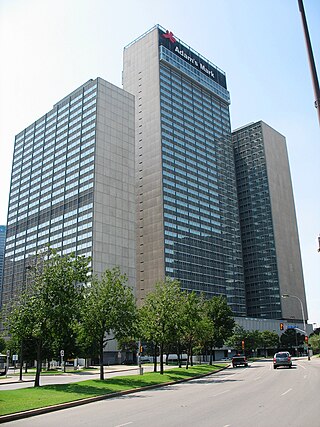
The Sheraton Dallas Hotel, formerly the Adam's Mark Hotel and originally the Southland Center, is a complex of International Style skyscrapers located in the City Center District of downtown Dallas, Texas. The hotel is the largest and second tallest hotel in Dallas and Texas with 1,840 guest rooms and 260,000 sq ft (24,000 m2) of meeting space. It has been host to pop culture conventions such as Project A-Kon and TwiCon.

The Main Court Building is an office building in Buffalo, New York located on the corner of Main Street and Court Street across the Buffalo Metro Rail from Lafayette Square. It is 188 feet (57 m) and stands 13 floors high. The tower is located across Court Street from the Liberty Building.

The Old Post Office, also known as U.S. Post Office, is a historic post office building located at 121 Ellicott Street in Buffalo in Erie County, New York within the Joseph Ellicott Historic District. It is currently home to the City Campus of SUNY Erie.
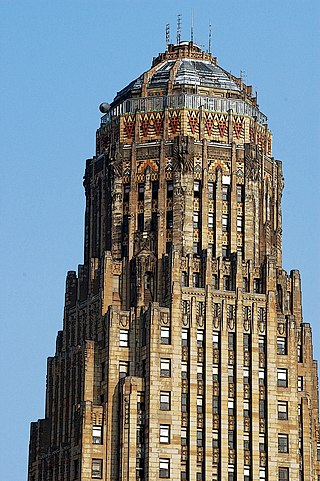
The Architecture of Buffalo, New York, particularly the buildings constructed between the American Civil War and the Great Depression, is said to have created a new, distinctly American form of architecture and to have influenced design throughout the world.
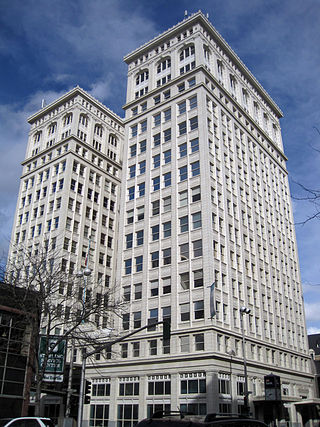
The U.S. Bank Building, previously the Old National Bank Building, is a high-rise in Spokane, Washington, United States. Having been completed in 1910, it was the first skyscraper in the Inland Northwest. At 219 ft (67 m) tall, the building was the tallest in the state of Washington from 1910 to 1911, when it was surpassed by the Key Bank Center in Tacoma—which itself was far surpassed by Seattle's Smith Tower in 1914. It remained the tallest building in Spokane, until the 1929 completion of the Paulsen Medical and Dental Building, located across the street.

The Erie County Savings Bank building was a 10-story Romanesque Revival, office and bank branch building that was located at present-day 9 Church Street in downtown Buffalo, New York.



















